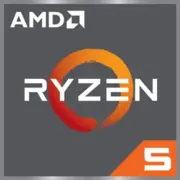AMD Ryzen 5 PRO 7530U

AMD Ryzen 5 PRO 7530U: A Balance of Power and Battery Life for Mobile Tasks
Architecture and Technology Process: Zen 3 and 7nm for Efficiency
The AMD Ryzen 5 PRO 7530U processor, developed under the codename Barcelo-R, is based on the Zen 3 architecture — one of AMD's most successful generations. This is a 7nm chip manufactured using TSMC's FinFET technology, which provides high transistor density and energy efficiency.
- Cores and Threads: 6 cores and 12 threads. This configuration is ideal for multitasking and applications that utilize parallel computing.
- Clock Speeds: Base frequency — 2.8 GHz, maximum Turbo Boost frequency — up to 4.5 GHz. This allows the processor to quickly adapt to workloads: from energy saving during idle to high performance during rendering or compiling code.
- Cache: 16 MB L3 cache speeds up the processing of frequently used data, reducing latency.
- Integrated Graphics: Radeon Graphics with 6 compute units (384 stream processors) and a frequency of up to 2 GHz. This is a modified version of Vega, optimized for office applications and light gaming.
The Zen 3 architecture has been improved over Zen 2: higher IPC (instructions per clock), redesigned cache structure, which is particularly noticeable in single-threaded tasks.
Power Consumption and TDP: 15 Watts for Thin Laptops
A TDP of 15 watts makes the Ryzen 5 PRO 7530U ideal for ultrabooks and business laptops. It strikes a "sweet spot" between performance and battery life:
- Heat Dissipation: Even under peak loads, the chip does not require massive cooling systems. For example, in Lenovo ThinkPad or HP EliteBook laptops, it operates with passive or compact active cooling.
- Dynamic Management: The Precision Boost 2 technology automatically adjusts frequencies and voltages based on temperature and load.
Performance: From Office Tasks to Light Gaming
Geekbench 6:
- Single-Core Test: 1737 points. This is on par with the Intel Core i5-1135G7 (1700-1800), which is sufficient for smooth operation in browsers, Word, or Photoshop.
- Multi-Core Test: 5400 points. Here, the Ryzen 5 PRO 7530U surpasses the Intel Core i5-1240P (5200) due to the higher core count.
Real-World Scenarios:
- Office Work: Simultaneous work with 20+ tabs in Chrome, Excel spreadsheets, and Zoom — without lag.
- Multimedia: Converting 4K video in HandBrake takes 25-30 minutes (compared to 35+ for the Intel i5-1135G7).
- Gaming: In Dota 2 or CS:GO at medium settings (720p) — 50-60 FPS. For Fortnite, the resolution needs to be reduced to 720p and settings to Low (40-45 FPS).
- Turbo Mode: During short bursts of activity (up to 10-15 seconds), the frequency can reach 4.5 GHz, but for extended tasks (rendering) it stabilizes at 3.6-3.8 GHz due to TDP limitations.
Use Cases: Who Is This Processor For?
- Students and Office Workers: Multitasking, document work, and video conferencing.
- Freelancers: Photo editing in Lightroom and simple video editing in Premiere Pro.
- Travelers: Compact laptops with long battery life.
- Casual Gamers: Integrated graphics can handle indie games and older AAA titles.
Not Suitable For:
- 3D modeling in Blender or rendering complex scenes.
- Streaming games in high quality.
Battery Life: Up to 10 Hours of Use
Under typical loads (brightness at 50%, Wi-Fi, Office work), a laptop with the Ryzen 5 PRO 7530U runs for 8-10 hours. In power-saving mode — up to 12 hours. Factors contributing to this include:
- AMD Technologies: PowerNow! (similar to Intel SpeedShift) for dynamic frequency adjustment, CPPC (Collaborative Power and Performance Control) for core optimization.
- Idle Power Savings: In standby mode, the processor reduces power consumption to 1-2 watts.
Comparison with Competitors
1. Intel Core i5-1235U: 10 cores (2P + 8E), 12 threads. Better for single-threaded tasks (Geekbench 6 Single Core — 1800+), but falls short in multi-threaded tasks (5000-5200). Higher price, comparable power consumption.
2. Apple M1: Better energy efficiency (up to 15 hours of use), but a limited ecosystem (macOS). In multi-threaded tasks, the Ryzen 5 PRO 7530U is 10-15% faster.
3. AMD Ryzen 5 5625U (previous generation): Minimal performance difference (Zen 3 vs. Zen 3), but the 7530U has improved support for LPDDR5 memory.
Pros and Cons
Strengths:
- High multi-threaded performance.
- Energy efficiency for thin laptops.
- Support for PRO technologies (encryption, remote management).
Weaknesses:
- Integrated graphics are weaker than Intel Iris Xe in gaming.
- Lags behind H-series processors under peak loads (e.g., rendering).
Recommendations for Choosing a Laptop
1. Device Type: Ultrabooks (ASUS ZenBook, Lenovo Yoga), business laptops (Dell Latitude, HP ProBook).
2. Important Parameters:
- Cooling: Even with a TDP of 15W, it's better to choose a model with dual fans.
- RAM: 16 GB DDR4/LPDDR5.
- Storage: NVMe SSD with 512 GB or more.
- Display: IPS panel with FHD resolution, for multimedia — sRGB coverage of 90%+.
Final Conclusion
The AMD Ryzen 5 PRO 7530U is a processor for those who value balance. It is suitable for:
- Users who need performance for work and moderate creativity.
- Those who frequently work on the go and do not want to sacrifice battery life.
- Corporate clients who value PRO features for data protection.
Key Benefits: 6 cores, 12 threads, and a 7nm technology process ensure smooth operation in multitasking, while a TDP of 15W guarantees a long battery life. If you are looking for a laptop for studying, office work, or travel — the Ryzen 5 PRO 7530U should be at the top of your list.
Basic
CPU Specifications
Memory Specifications
GPU Specifications
Miscellaneous
Benchmarks
Compared to Other CPU
Share in social media
Or Link To Us
<a href="https://cputronic.com/cpu/amd-ryzen-5-pro-7530u" target="_blank">AMD Ryzen 5 PRO 7530U</a>